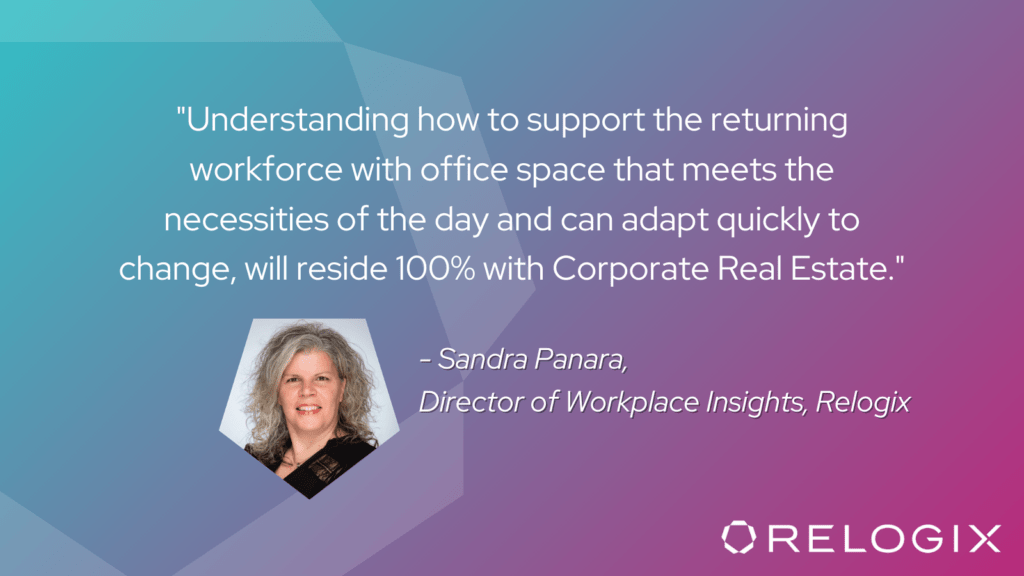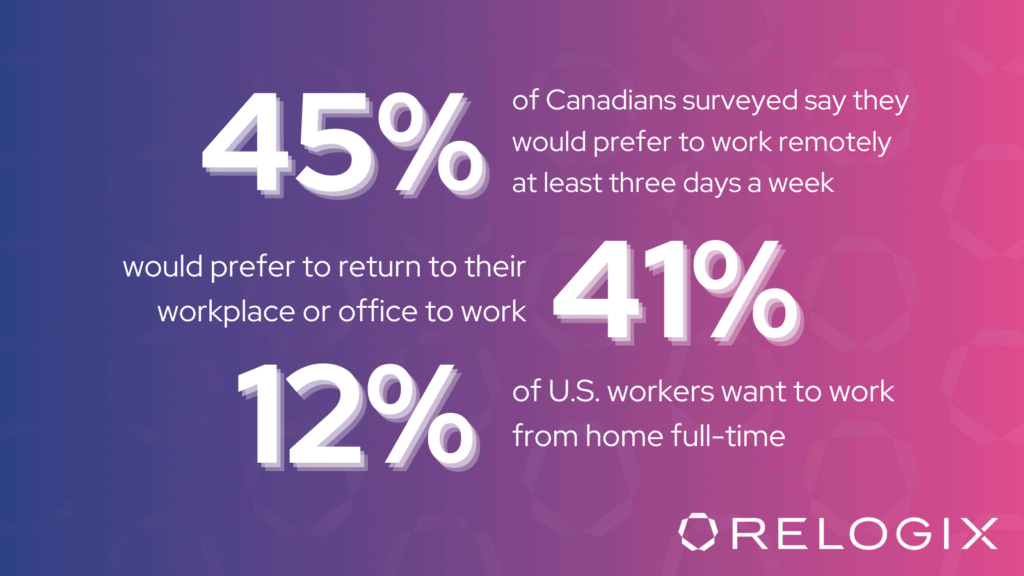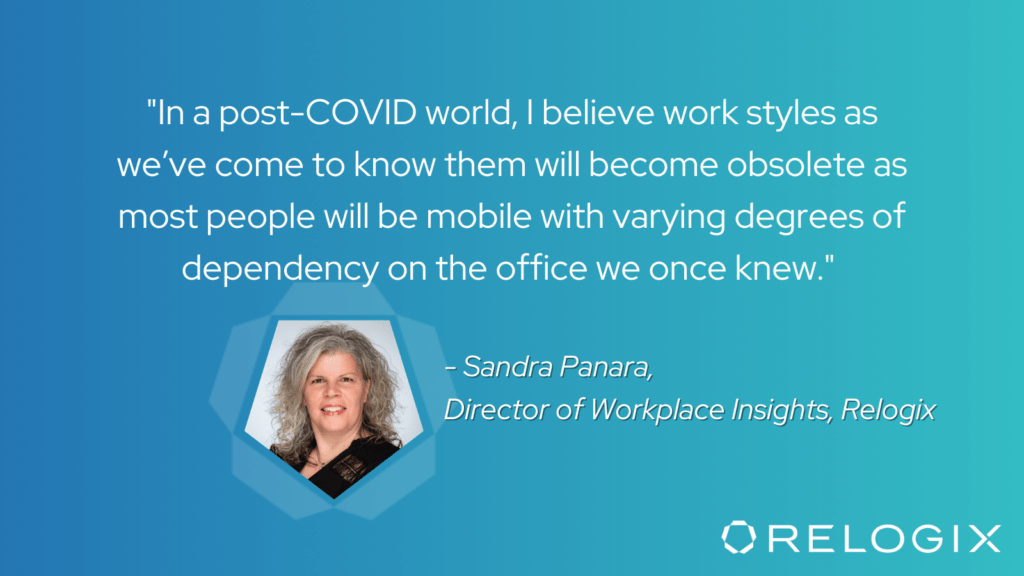Change and Opportunity in A Disrupted Corporate Real Estate World Part Two: All -Ize On Corporate Real Estate
While our current ideas about the role of the office may have served some of us pre-COVID, the role of offices as we once knew it no longer applies to all of us. As our needs continue to change in unexpected ways, we require true flexibility that transcends return to office strategies. It should not only address our current challenges, but also build resiliency to help us move confidently into the future.
“Workers will be drawn to in-person work only to the extent that the office addresses psychological needs that the pandemic undercut… Safety, belonging and autonomy are three of the primary drivers of an individual’s sense of well-being, and all three have been obliterated by the pandemic.” – NPR
People need a reason to come back to the office and that reason will vary person to person. Identifying requirements to support an unpredictable demand for office space will be challenging. The only way to achieve this is to consider several options for how we address in-office workspace demand. We must also remain open to the possibilities of implementing a unique blend of these options at any given time.
COVID has inadvertently decoupled workspace and office by proving that productive and purposeful work can happen anywhere. As we continue to explore how we adjust our workplace strategies, we must consider the role of all spaces where work happens and the ways we interact with those spaces. This helps narrow down how much office space will be required. We must be willing to recognize that our workplace strategies can – and should – change as needs and expectations evolve.
Flexible Workplace Strategies Through The –Ize of CRE
There are several CRE workplace strategy objectives, and each yields a different outcome.
Regardless of which approach is undertaken, it will impact every employee differently. Identifying the best approach to take happens when overarching corporate business drivers and objectives help shape which strategy is implemented. Office space is a tool – it is a means to an end.
On the other hand, key indicators of company success and objectives are presented as an organization’s mission and values – the ways in which a company communicates its purpose or its ‘why’. As we think about strategic objectives, we should be thinking about the stories we want to tell. We should be thinking about stories that explain an organization’s “why”. We should be thinking about those stories which inspire employees, customers, and stakeholders, alike.
Common CRE Efficiency Strategies
Maximize:
max·i·mize (v): Maximizing space, or densification, involves fitting as many people as possible into an office.
Maximizing space, or densification, involves fitting as many people as possible into an office. This approach typically offers little to no private office area. It is composed predominantly of workstations that are contained in a small footprint, e.g. benching and desk-sharing.
In our current circumstances, this is problematic because of the proximity it creates between people, but of course could become a possibility again as the vaccine becomes more widely available. In the future, if the economy takes a sharp downturn, the pressure will be on to reduce and save wherever we can.
Optimize:
op·ti·mize / (v): Optimizing space aims to improve the use of space, right-sizing space to suit demand.
Optimizing space aims to improve the use of space, right-sizing space to suit demand. It demands a re-think of the purpose of the office and a change of expectations by building owners, occupiers and users. Optimizing usually involves observing how the space is used and then adjusting allocation and provisioning to align with the demand of different space typologies.
In this case, technology plays a huge role in the future of the office. The collection and analysis of real-time occupancy and desk utilization data ensures that when people return to the office, they’re returning to work-appropriate, healthy and safe environments. Optimization of space is often followed by rationalization and modernization.
Rationalize:
ra·tion·al·ize / (v): Rationalizing space is the next step that follows optimization. Excess space, as a result of optimization efforts, is divested to yield desired savings.
Typically, rationalizing space is the next step that follows optimization. There will likely be excess space as a result of optimization efforts and this space can be divested to yield desired savings. Often, surplus space is off-loaded to coincide with optimized usage, in an attempt to reduce costs. The challenge is deciding how much to rid of and what to hold on to.
Making that decision is made more difficult in our current environment as we challenge traditional assumptions of what we think the office should look like. Companies may see this time as an opportunity to downsize, reduce operating costs and invest in technology to support work from anywhere, should it become our permanent reality.
Modernize:
mod·ern·ize / (v): The re-purposing of excess space to support wellness and socializing by creating spaces like cafes and open collaboration areas.
Modernizing space is the re-purposing of excess space. This usually involves provisioning spaces more social in nature and support wellness at work, such as lounges, games areas, open collaboration spaces, kitchens/cafes, fitness and meditation areas, etc. Modernization is essentially the redeployment of surplus space.
If modernization is the goal, organizations are typically looking for smart spaces, filled with services they can use to be more productive. Modernization often incorporates sustainability initiatives and wellness solutions in addition to any digital transformations needed to keep their talent safe and healthy in an office setting.
Revolutionize
rev·o·lu·tion·ize / (v): The idea of office space, not as a “single destination”, but as an ecosystem of places. Any space can be a workspace, depending on unique needs, at any time.
By revolutionizing the idea of office space, we begin to see the dissolution of the notion that we either work remotely or in an office. We redefine ‘office space’ (a single destination) as ‘workspaces’ (an ecosystem of places). Any space can be a workspace, depending on individual or team requirements at any given time.
Moving forward, this is a cost-effective alternative to modernization by outsourcing the need for flex space to co-working spaces. Through dedicated or on-demand co-working spaces, companies can maintain brand experience while decentralizing the office to support sustainability initiatives. Employees working from home can access space on-demand wherever they are via co-working suppliers around the globe.
Another aspect of revolutionizing office space is the continuing evolution of the office, as we know it:
“Successful offices of the future may have more in common with retail or entertainment venues that compete for every visit by offering a compelling, constantly evolving experience… Could an office ever inspire that most potent of 21st-century emotions, ‘fear of missing out’?” ~ WSP
By redefining the office space as a compelling destination with entertaining experiences that dynamically evolve, we begin to see how important it will be to have office environments that allow for, and embrace, change as it happens.
It’s Time To Tell New Stories
As the pandemic precipitated a global work from home experiment, we need to start thinking about the value of ‘work from anywhere’ culture and what it means for the role of traditional Corporate Real Estate teams. While we prepare for the dynamic flexibility our office environments will require moving forward, we also need to understand how to communicate the changes we make in a way that will resonate with employees, customers and stakeholders.
The key to implementing any new workplace strategy is surfacing unique and compelling stories to support change for the greater good. These unique stories – grounded in supporting data – will give meaning to organizational shifts. Use them as a roadmap for communication and implementation. If you’d like to learn more about creating your data story – a unique narrative that fits your organization during this time of change – register here for our Data Stories and Corporate Real Estate Seminar Series





